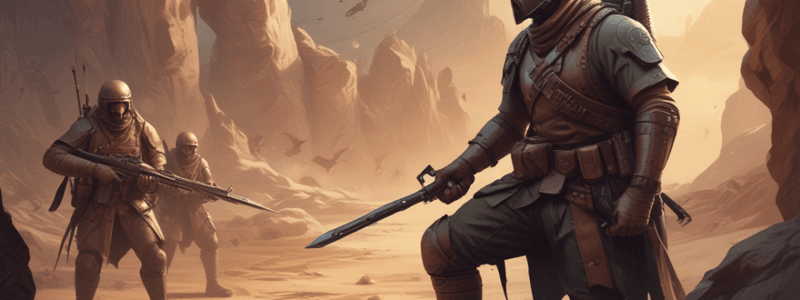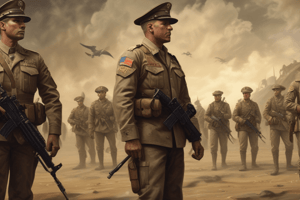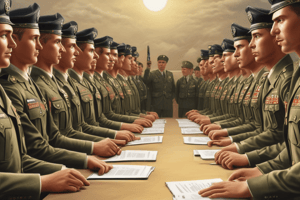Podcast
Questions and Answers
What is considered the foremost requirement for potential leadership?
What is considered the foremost requirement for potential leadership?
- Humility (correct)
- Aggressive behavior
- Decentralized command
- Prioritize and execute
What is the purpose of finding a strong point?
What is the purpose of finding a strong point?
- To abandon the mission
- To stay idle and wait for orders
- To take aggressive action
- To find protection behind concrete walls and set security (correct)
What is the ultimate goal of a leader?
What is the ultimate goal of a leader?
- To avoid responsibility
- To work themselves out of a job (correct)
- To maintain power and authority
- To give orders and be obeyed
What is the result of a leader opposing too much authority?
What is the result of a leader opposing too much authority?
What is the benefit of recognizing and balancing dichotomies in leadership?
What is the benefit of recognizing and balancing dichotomies in leadership?
What is the consequence of a leader training their people too hard?
What is the consequence of a leader training their people too hard?
What is the phrase 'Last man' used for in combat?
What is the phrase 'Last man' used for in combat?
What is the balance that every leader must find in leadership?
What is the balance that every leader must find in leadership?
What do the best leaders and teams do when they make mistakes?
What do the best leaders and teams do when they make mistakes?
What is the first law of combat?
What is the first law of combat?
Why is simplicity important in planning and orders?
Why is simplicity important in planning and orders?
What happens when plans and orders are too complex?
What happens when plans and orders are too complex?
What is the purpose of prioritizing and executing?
What is the purpose of prioritizing and executing?
What is the benefit of decentralized command?
What is the benefit of decentralized command?
What is required for decentralized command to be effective?
What is required for decentralized command to be effective?
What is the foundation of good leadership?
What is the foundation of good leadership?
What do leaders need to walk in order to be effective?
What do leaders need to walk in order to be effective?
What can happen if leadership qualities are taken too far?
What can happen if leadership qualities are taken too far?
What happens when balance is lost in leadership?
What happens when balance is lost in leadership?
What is the result of a leader taking too much ownership of everything in their world?
What is the result of a leader taking too much ownership of everything in their world?
When a team member fails to perform adequately, what should a leader do?
When a team member fails to perform adequately, what should a leader do?
What is the goal of this book?
What is the goal of this book?
What is the ultimate dichotomy of leadership that a combat leader must face?
What is the ultimate dichotomy of leadership that a combat leader must face?
What happens when a leader cares too much about accomplishing the mission?
What happens when a leader cares too much about accomplishing the mission?
What is the result of a leader developing overly close relationships with team members?
What is the result of a leader developing overly close relationships with team members?
Why is it important for a leader to find balance?
Why is it important for a leader to find balance?
What is the challenge of leadership?
What is the challenge of leadership?
What is the result of a leader being too detached from the team?
What is the result of a leader being too detached from the team?
What is the burden of command that a leader feels?
What is the burden of command that a leader feels?
What is the purpose of a crash grenade or flash bang?
What is the purpose of a crash grenade or flash bang?
What is the result of micromanaging a team?
What is the result of micromanaging a team?
What is the opposite of micromanaging in leadership style?
What is the opposite of micromanaging in leadership style?
What is the consequence of a hands-off leader not providing clear direction?
What is the consequence of a hands-off leader not providing clear direction?
What is the most difficult dichotomy of leadership?
What is the most difficult dichotomy of leadership?
What is the benefit of decentralized command?
What is the benefit of decentralized command?
What is the role of ownership in leadership?
What is the role of ownership in leadership?
What is a warning sign of micromanaging?
What is a warning sign of micromanaging?
How should a leader explain the mission to the team?
How should a leader explain the mission to the team?
What is a common symptom of a team that lacks clear guidance from its leader?
What is a common symptom of a team that lacks clear guidance from its leader?
What should a leader do to get their team back on course?
What should a leader do to get their team back on course?
What is the result of a leader taking too much ownership?
What is the result of a leader taking too much ownership?
What is the key to achieving maximum effectiveness from a team?
What is the key to achieving maximum effectiveness from a team?
What is the purpose of decentralized command?
What is the purpose of decentralized command?
What is the consequence of a leader being overbearing and focusing on trivial matters?
What is the consequence of a leader being overbearing and focusing on trivial matters?
What is the benefit of a leader giving their team ownership and autonomy?
What is the benefit of a leader giving their team ownership and autonomy?
What is the result of a leader not holding their team to high standards?
What is the result of a leader not holding their team to high standards?
What is the importance of a leader finding a balance between being firm and flexible?
What is the importance of a leader finding a balance between being firm and flexible?
What is the consequence of a leader not providing clear guidance to their team?
What is the consequence of a leader not providing clear guidance to their team?
What is the primary goal of training in a team?
What is the primary goal of training in a team?
What is the result of leaders who don't push their team to excel?
What is the result of leaders who don't push their team to excel?
What is the purpose of challenging frontline leaders in junior or less experienced personnel?
What is the purpose of challenging frontline leaders in junior or less experienced personnel?
What is the strategic goal of training?
What is the strategic goal of training?
What is the benefit of repetitive training?
What is the benefit of repetitive training?
What is the most important piece of information on the battlefield?
What is the most important piece of information on the battlefield?
What is the ultimate goal of a leader in terms of their team members?
What is the ultimate goal of a leader in terms of their team members?
What happens when a leader continues to invest in a non-performing team member?
What happens when a leader continues to invest in a non-performing team member?
What is the balance that leaders must find in being aggressive?
What is the balance that leaders must find in being aggressive?
What is the purpose of staying calm on the radio?
What is the purpose of staying calm on the radio?
What is the purpose of training in MOUT, BUD/S, and FTXs?
What is the purpose of training in MOUT, BUD/S, and FTXs?
What is the focus of the best training programs?
What is the focus of the best training programs?
What is the importance of debriefing after training?
What is the importance of debriefing after training?
What is the consequence of overlooking the limitations of individuals?
What is the consequence of overlooking the limitations of individuals?
What is the result of hard training?
What is the result of hard training?
What is the principle of extreme ownership in leadership?
What is the principle of extreme ownership in leadership?
What is the balance that a leader must find in terms of training?
What is the balance that a leader must find in terms of training?
What is the role of a leader in terms of their team members' performance?
What is the role of a leader in terms of their team members' performance?
What is the importance of recognizing and acknowledging dichotomies in leadership?
What is the importance of recognizing and acknowledging dichotomies in leadership?
What is the result of a leader's failure to remove a non-performing team member?
What is the result of a leader's failure to remove a non-performing team member?
What is the primary goal of a leader in evaluating when and where to hold the line and when to allow some slack?
What is the primary goal of a leader in evaluating when and where to hold the line and when to allow some slack?
What is the result of a leader expending leadership capital foolishly?
What is the result of a leader expending leadership capital foolishly?
What is the most important explanation a leader can give to the team?
What is the most important explanation a leader can give to the team?
What is the relationship between discipline and freedom?
What is the relationship between discipline and freedom?
What is the primary goal of a leader in developing team members?
What is the primary goal of a leader in developing team members?
What is the key to developing unit camaraderie?
What is the key to developing unit camaraderie?
What is the most important factor in becoming a cohesive group?
What is the most important factor in becoming a cohesive group?
What is the primary role of a leader in relation to their team members?
What is the primary role of a leader in relation to their team members?
What is the common spirit existing in the members of a group, inspiring enthusiasm, devotion, and a strong regard for the honor of the group?
What is the common spirit existing in the members of a group, inspiring enthusiasm, devotion, and a strong regard for the honor of the group?
What do most underperformers need, according to the text?
What do most underperformers need, according to the text?
What does 'aggressive' mean in the context of leadership?
What does 'aggressive' mean in the context of leadership?
What is the risk of being overly aggressive as a leader?
What is the risk of being overly aggressive as a leader?
What is the 'disease of victory' in the context of leadership?
What is the 'disease of victory' in the context of leadership?
What is the balance that leaders must find in their approach?
What is the balance that leaders must find in their approach?
What is the key to achieving strategic victory as a leader?
What is the key to achieving strategic victory as a leader?
What is the pitfall of being overly aggressive as a leader?
What is the pitfall of being overly aggressive as a leader?
How should leaders approach decision-making?
How should leaders approach decision-making?
What is the key to achieving success as a leader?
What is the key to achieving success as a leader?
Flashcards are hidden until you start studying
Study Notes
Leadership and War
- War is a brutal instructor that teaches about the fragility of human life and the power of the human spirit.
- The book is based on lessons learned from the battle of Ramadi in 2006.
Four Laws of Combat
- The first law is cover and move: teamwork is essential, and every individual and team must support each other to accomplish the mission.
- The second law is simple: complexity breeds chaos and disaster, and plans must be simplified so that everyone understands the overall goal.
- The third law is prioritize and execute: leaders must detach themselves, assess the situation, and prioritize tasks to ensure effective execution.
- The fourth law is decentralized command: no one leader can manage everything, and leaders at every level must be empowered to make decisions.
Balance in Leadership
- Leadership requires balance between opposing forces, such as leading and following, and taking ownership and empowering others.
- Every leader must find the equilibrium between contradictory qualities, such as being confident and cautious, aggressive and thoughtful.
- Balance is crucial to victory, and imbalance can lead to leadership suffering and poor team performance.
The Dichotomy of Leadership
- A leader must care deeply for their team members, but also put them at risk to accomplish the mission.
- A leader must balance being a leader and a follower, being confident and cautious, and being aggressive and thoughtful.
- The ultimate dichotomy of leadership is caring for the troops while also accomplishing the mission.
Decentralized Command
- Decentralized command is essential, but it can be taken too far, leading to a lack of direction and coordination.
- Leaders must balance giving guidance and freedom to make decisions, and must clearly implement the chosen course of action.
- The key is to maintain equilibrium, where the team has the guidance to execute, but also the freedom to make decisions.
Leadership Capital
- Leadership capital is the recognized power that a leader possesses, which can be expended wisely or foolishly.
- Leaders must carefully evaluate when and where to hold the line and when to allow some slack, and must prioritize areas where standards cannot be compromised.
- The most important explanation a leader can give to the team is "why", particularly when enforcing standards.
Discipline and Freedom
-
Discipline equals freedom, and leaders must balance being resolute where it matters, but never overbearing.
-
Leaders must prioritize where to hold the line and enforce standards, and must carefully balance the dichotomy between discipline and freedom.### Effective Leadership
-
A leader's personal mission is to train, coach, and mentor team members to perform at their highest standards.
-
Understanding when to hold the line and when to be flexible is crucial to increase leadership capital.
-
A leader must make tough decisions, including letting go of underperformers who cannot be improved despite efforts.
Building Unit Camaraderie
- Hard work and pushing team members during training foster a sense of esprit de corps.
- Taking ownership of team members' performance and being confident in their abilities is essential for a leader.
Leading Individuals
- Leaders are responsible for the output of their team members.
- The goal is to maximize each individual's potential to reach the team's maximum potential.
- A leader must balance between taking care of individual team members and removing those who negatively impact the team.
Extreme Ownership
- The mantra "not bad teams, only bad leaders" can have a positive outcome when leaders take ownership of their team's performance.
- A leader must remember that the team's performance trumps an individual's performance.
Leadership and Training
- Training scenarios should create chaos and mayhem to challenge leaders and humble them.
- Simunition is a non-lethal training ammunition used to provide realistic training.
- Training must be challenging but not overwhelming, and should focus on realism, fundamentals, and repetition.
- Debriefing after training is crucial to analyze what went right and wrong.
Decentralized Command
- Leadership at every level is critical to a team's success.
- The goal of training is to build a culture of decentralized command, where leaders at every level take charge and act decisively.
Hard Training
- Hard training is essential to build capable leaders at every level of the team.
- The best leaders often learn through experience what works and what doesn't, and push their people to excel.
Aggressive Leadership
- Aggressive leadership means being proactive and taking action to solve problems, not being angry or aggressive towards team members.
- A leader must balance aggression with thought and analysis to ensure risks have been assessed and mitigated.
- Aggression is critical to achieving strategic victory, but caution must be exercised to avoid recklessness.
Balancing Aggression and Caution
- A leader must balance aggression with clear, unemotional thought and sensible risk mitigation.
- Being aggressive doesn't mean throwing caution into the wind or taking catastrophic risks.
- A leader must fight against the "disease of victory" and avoid becoming complacent despite success.
Studying That Suits You
Use AI to generate personalized quizzes and flashcards to suit your learning preferences.




